The Complete Guide to Tandem Paragliding
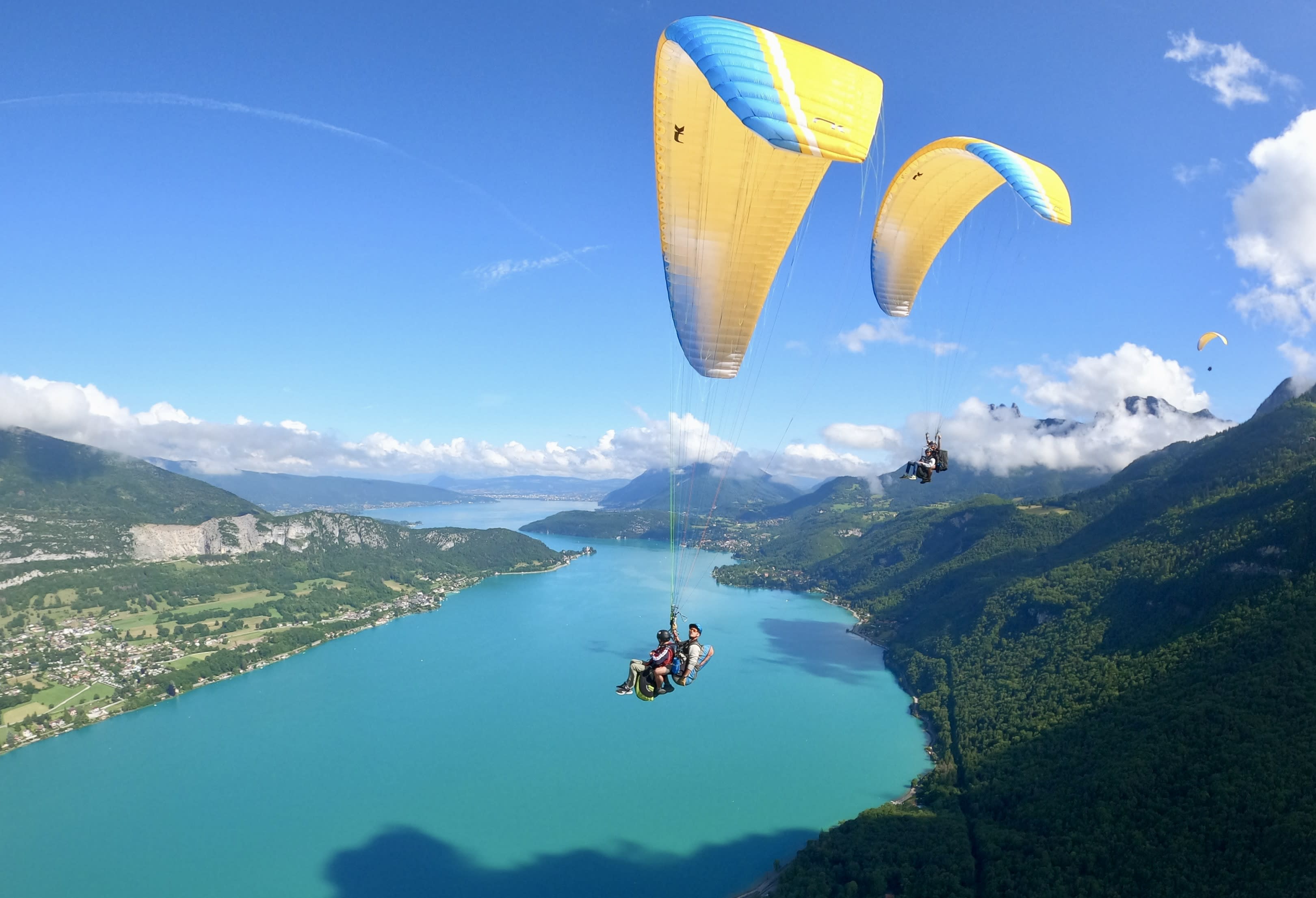
Discover all the things you should know on tandem paragliding, an activity accessible to everyone! From details of this practice to the equipment, you will be an expert and ready to take off after reading it!
Paragliding, a thrilling outdoor sport, offers an exhilarating way to experience the freedom of flight. Unlike traditional aviation, paragliding involves a lightweight, free-flying, foot-launched glider aircraft, where the pilot sits in a harness suspended below a fabric wing. This wing shape is maintained by suspension lines, aerodynamic forces, and air pressure.
How tandem paragliding works?
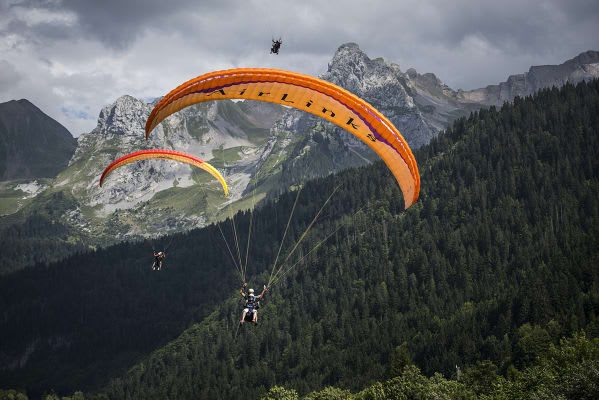
Tandem paragliding is an adventure sport and one of the best ways to traverse the skies and the closest way to feeling how it is to be a bird. Requiring only a harness, a fabric paragliding canopy, and good weather conditions, this ecological activity (environmentally friendly at the point of takeoff – but transport to the takeoff site and from the landing site may be required), is a great way to see new destinations from perspectives that most people may not gain.
This sport has two main flight types: soaring and thermal flying.
Soaring flights can have the same takeoff and landing point and are often taken along sea cliffs, ridges and sand dunes, with takeoffs from low heights and coastal winds utilised to gain height.
Thermal flights allow you to gain height and can last for varying lengths of time, from just a few minutes to a number of hours. These kinds of flights depend on the season, as hot temperatures are needed to keep the paraglider in the air. The warmth of the sun heating up rock faces creates hot columns, or pockets, of air that rise.
There are two additional types of flights, regular flights in which you tandem paraglide from a higher altitude to a lower landing site, what most tandem paragliding companies do in the mountains, where gliding down is key.
On the other hand, aerobatic flights, are an exhilarating stunt-filled variation of the above type of tandem paragliding flight, great for thrill seekers. Below is an example of aerobatics.
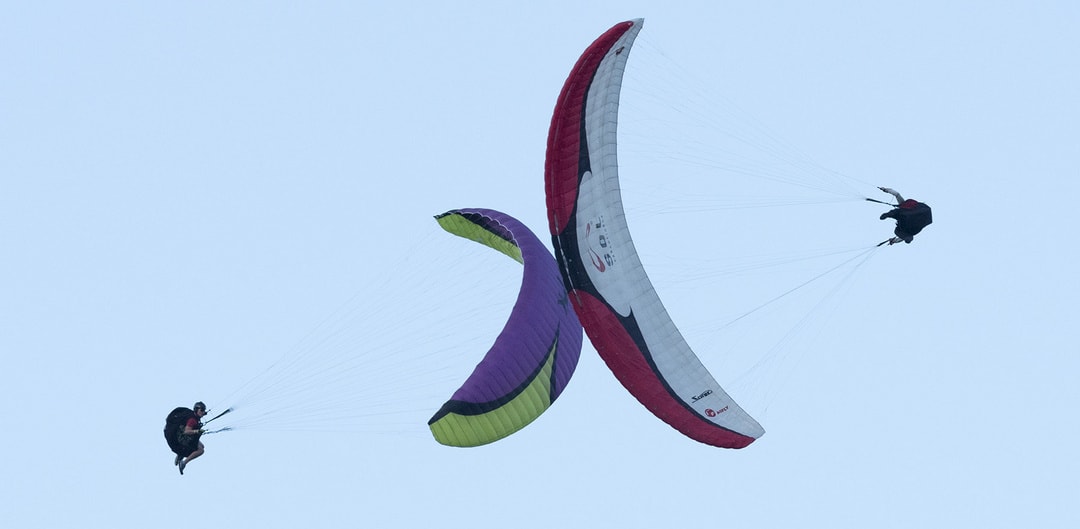
Paragliding is a sport that is highly dependent on weather and wind conditions, as rain, snow and thick clouds can affect whether it is safe to fly. Tandem paragliding flights can still be taken in winter however, but they are often shorter, unless the takeoff point is from a higher altitude, using heights rather than thermals.
Tandem paragliding is an aerial thrill that is relatively inexpensive, in comparison with sports such as skydiving. And though it's very dependent on the weather conditions, it offers an unparalleled thrill and stunning views of lakes, mountains, forests, sand dunes and coastlines (to name a few).
Who can do tandem paragliding?

Tandem paragliding can be done by anyone over the age of 4 (subject to some height and/or weight restrictions) and who are able to run a short distance, as this may be required on takeoff and landing, depending on the location. Even though tandem paragliding flights are done in tandem with an instructor, younger fliers will need written parental consent before flying and a guardian with them on the day.
Tandem paragliding is an inclusive and accessible sport, with a growing number of instructors across the globe trained and certified to take those with reduced mobility, physical disabilities, as well as deaf or hearing impaired fliers and blind or visually impaired fliers, in the air. Some centers like FLYEO offers a paragliding experience for children over Lake Annecy so you can rest assured that your little ones are in good hands!
Can I do a tandem paragliding flight if I suffer from vertigo?
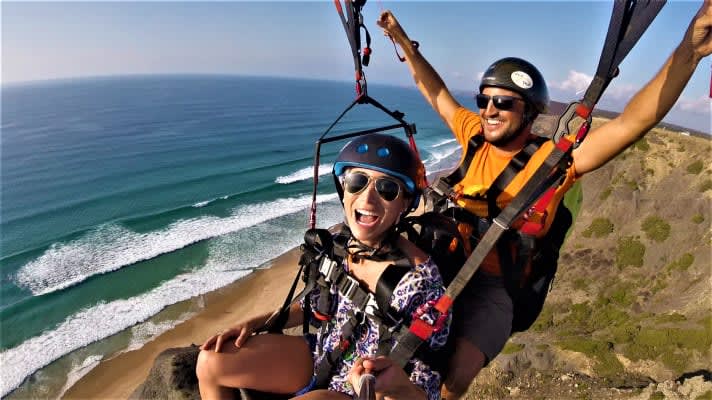
This is a frequently asked question when it comes to paragliding and the answer is simple, even if it might surprise you: with paragliding you cannot feel vertigo, due to the smooth continual movement involved in the sport. Vertigo only can only be felt when standing on a physical object/in physical contact with the ground. As long as you do not touch the ground in some ways, the concept of vertigo does not exist.
Those with a fear of heights or vertigo are encouraged to try tandem paragliding if they’re interested, as many people find it accessible for them with these fears, noting the comforting effect of being able to speak to the pilot whilst flying. Fliers with these fears have also enjoyed the smoothness of their tandem paragliding flight (dependent on time of year and location), noting it to be calming and feeling like they were gliding or soaring, rather than falling, as some people may worry about this sensation.
What equipment is needed for tandem paragliding?
Tandem paragliding is quite a simple sport in terms of the equipment but there are of course essentials that are indispensable like a canopy, helmets, two chair-like harnesses (one for the pilot and one for the passenger to sit in and be strapped to the canopy), back up parachutes, a radio and a variometer (an instrument used for measuring altitude gain/loss).
The ‘ram air airfoil’ or the paragliding canopy is made of two sets of sturdy ‘ripstop polyester’ - a reinforced and tear-resistant fabric. A seat-like harness is also necessary to attach you to the pilot and the paragliding canopy. All tandem paragliding instructors will provide the necessary technical equipment for the flight, as well as the safety equipment needed.
What should you bring for a tandem paragliding flight?

You probably wonder what to wear for a paragliding flight. Well, wearing closed-toe footwear, suitable for the terrain that you will be taking off from and landing on, is important. Wearing layers of clothing to keep warm from oncoming winds, is also important, as this activity is very static as you will be sat in the tandem paraglider not doing much moving yourself, you are likely to feel the coldness of the wind. Sometimes waterproof over-clothes may be needed. Sunglasses are also advisable.
How long does a tandem paragliding flight last?
This is another frequently asked question, and a tricky one… On average, a ‘normal’ discovery tandem flight will last between 10 and 20 minutes, depending on the altitude difference between the take-off and landing sites. Coastal (soaring) or thermal flights can sometimes be optionally chosen, and flight lengths can be increased greatly, but will always remain dependent on wind/thermals conditions.
What will I do during a tandem paragliding flight?
Pre-flight
The length of the flight and of the activity as a whole, including transport times, can vary, as the time it takes to get from a city to an out-of-town take off spot may be longer than if you are taking off from a mountainous area that you are already on holiday in.
Most tandem paragliding flights will go as such: you will meet your instructor at a pre-determined point, often the landing site, and take transport to the takeoff point. At the take-off spot your instructor will prepare the paragliding canopy, put your harness on, and attach it to their canopy.
During the flight
Once everything is safety checked, depending on the location, you and the pilot will need to take a small run of around 5 – 15 metres until you leave the ground and begin your flight. The distance necessary is dependent on the wind strength and the terrain of the takeoff point. If you are taking a thermal flight, the instructor will search for air pockets to take advantage of, to get more height.
Whilst flying, it is possible to interact with the pilot as the wind is not normally too loud to talk over, and the instructor will likely give you details about the sites you are seeing below you as you fly or explanations of what they are doing to control or manoeuvre the glider.
Landing
When you near the end of the descent, the instructor will need to do a small loop to get to the level of the landing area, and you will need to put your legs up and let the instructor land it. After a successful landing, you will be helped to remove the harness and helmet and most likely have a small debrief and get on your way.
Variations of tandem paragliding
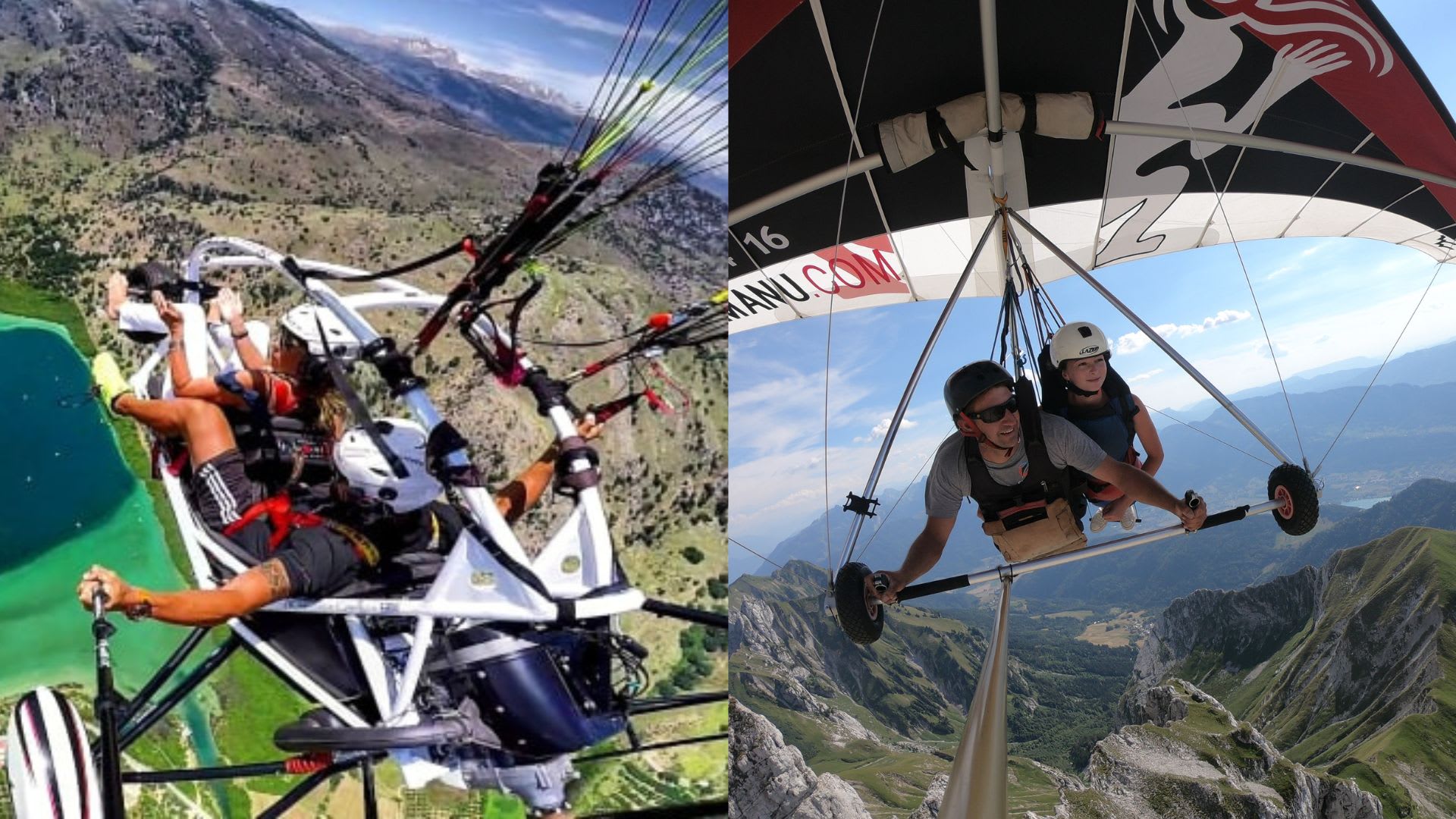
There are a number of sports baring some similarities to paragliding. Some share the same landing and takeoff sites and similar flight patterns, such as hang gliding, and some that use the same equipment but also use a motor, such as paramotoring.
Hang gliding, another aerial adventure sport
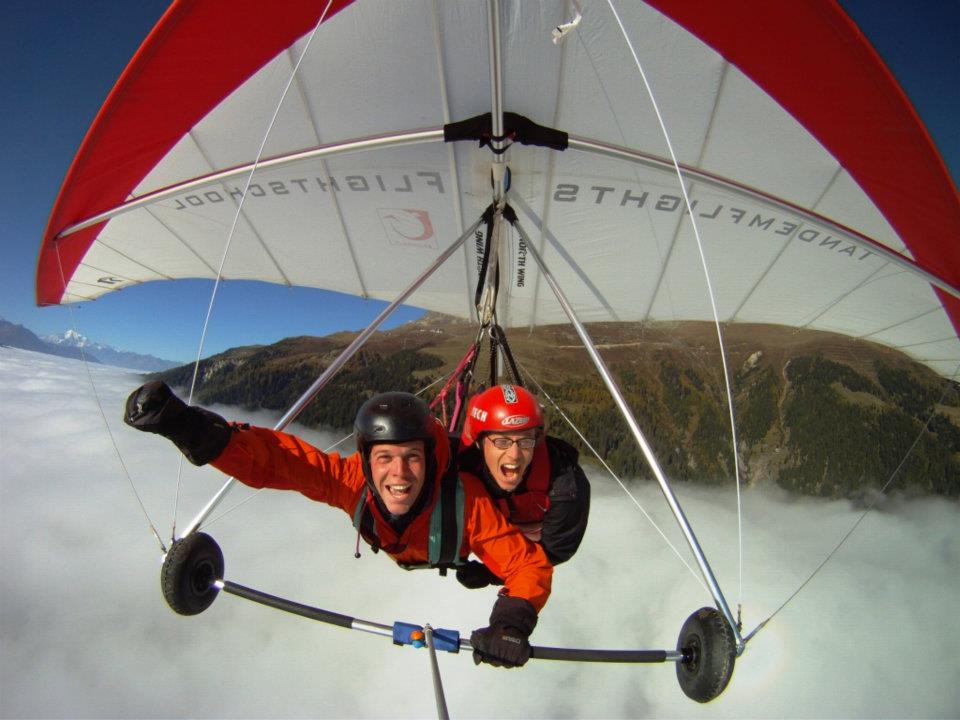
One that is often practiced in the same locations, sharing takeoff and landing points with paragliders. The difference between paragliding and hang gliding is a different canopy, with the latter sport requiring an aluminum glider, rather than the double-layer fabric canopy that paragliding uses. This sport also has a different flying experience, with the flier’s legs behind them rather than below, as in paragliding, and a different landing technique. Discover all the differences between paragliding and hang gliding to make your choice.
Paramotoring, another fantastic air-based sport
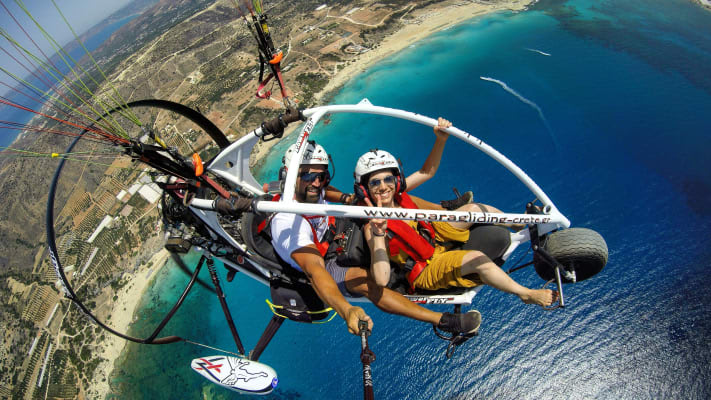
Paramotoring has the same canopy and flying style as paragliding, but uses a motor to land and has the possibility of keeping the motor running whilst flying. The motor can also be stopped whilst in the air and the pilot can use thermals like paragliding. Paramotoring is a less ecological variation of this sport, but can be done year round, and when weather conditions are more difficult.
Soar towards other adventures
If we’ve piqued your interest in this exhilarating aerial adventure sport, check out some of our other articles on tandem paragliding, including the best destinations in Spain, France, Greece and Africa to try the sport!
See you soon up in the air!